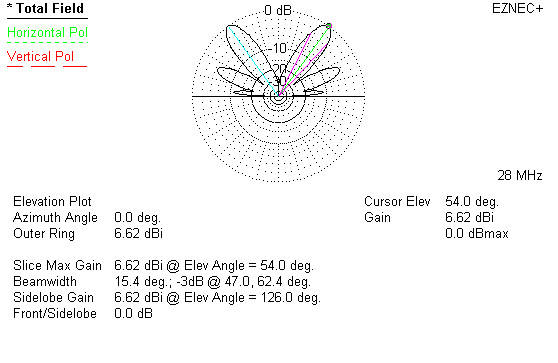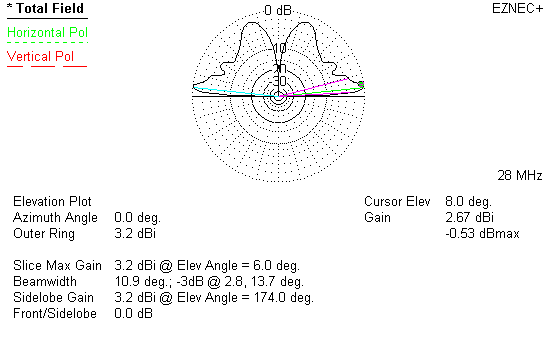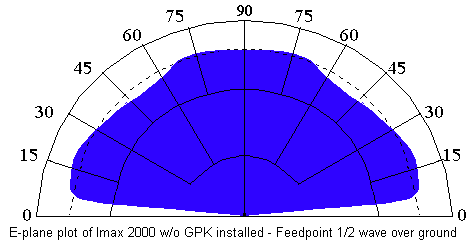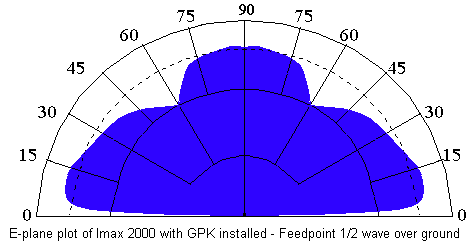On the face of it a 5/8 wave ground plane-less antenna, with the dual coils/capacitor matching section at the bottom. I have been reading that feed line radiation is part of the antennas design with all the ambiguity that causes for radiation pattern, TOA of elevation lobes, SWR issues and common mode on the coax issues.
I have tried mine today on 20ft of pole(no choke, no balun, no nothing), local signal reports seem to be up ! Great. What does that mean for DX ? I don't know as yet cause the conditions were not good enough to find out. In reality this will take 10-20 DX session to get even the slightest understanding of performance. Given that I wish to understand how to get those TOA lobes down. Is this antenna acting like the cloud warmer like the images we can find for this ground plane less antenna ?
Ahhhhhhhrgggg, that looks terrible:

(though to be fair the article in which this model is found in states "In this case I picked one of many worse-case feedline or mast lengths:" Which may not be the case with any given installation.
So the Solarcon GPK kit for the MAX2000 is not resonant (they are not long enough to be at 6ft, they fall short of 1/4 wavelength radials that a "normal 5/8 wave requires) so it will not likely reduce radiation angle. It may however keep some common mode currents off the coax. (when isolated from the mast)
I am wondering what to do to avoid those terribly high lobes burning holes in the Cumulo Nimbus.
Ahh.... that looks better... the article states: "This change is entirely the result of altering height and feedline/mast length!!!"

The full article and details regarding the MAX2000 on this page, near the bottom:
http://www.w8ji.com/end-fed_vertical.htm
What is the guaranteed way to get those lobes as low as possible ?
I suspect the answer to be.. 4 x horizontal 1/4 wave radials (Maybe 2 is sufficient ?) with isolation from the metal mast. I guess I am looking for confirmation/consolidation of all the things I have read on the MAX2000.
It is very convenient to pop the MAX2000 on a pole, very easy to screw the 3 sections together and you are away. It would seem that to ensure the antenna is working well for DX might be less practical and less convenient.
Thanks
I have tried mine today on 20ft of pole(no choke, no balun, no nothing), local signal reports seem to be up ! Great. What does that mean for DX ? I don't know as yet cause the conditions were not good enough to find out. In reality this will take 10-20 DX session to get even the slightest understanding of performance. Given that I wish to understand how to get those TOA lobes down. Is this antenna acting like the cloud warmer like the images we can find for this ground plane less antenna ?
Ahhhhhhhrgggg, that looks terrible:

(though to be fair the article in which this model is found in states "In this case I picked one of many worse-case feedline or mast lengths:" Which may not be the case with any given installation.
So the Solarcon GPK kit for the MAX2000 is not resonant (they are not long enough to be at 6ft, they fall short of 1/4 wavelength radials that a "normal 5/8 wave requires) so it will not likely reduce radiation angle. It may however keep some common mode currents off the coax. (when isolated from the mast)
I am wondering what to do to avoid those terribly high lobes burning holes in the Cumulo Nimbus.
Ahh.... that looks better... the article states: "This change is entirely the result of altering height and feedline/mast length!!!"

The full article and details regarding the MAX2000 on this page, near the bottom:
http://www.w8ji.com/end-fed_vertical.htm
What is the guaranteed way to get those lobes as low as possible ?
I suspect the answer to be.. 4 x horizontal 1/4 wave radials (Maybe 2 is sufficient ?) with isolation from the metal mast. I guess I am looking for confirmation/consolidation of all the things I have read on the MAX2000.
It is very convenient to pop the MAX2000 on a pole, very easy to screw the 3 sections together and you are away. It would seem that to ensure the antenna is working well for DX might be less practical and less convenient.
Thanks
Last edited:


